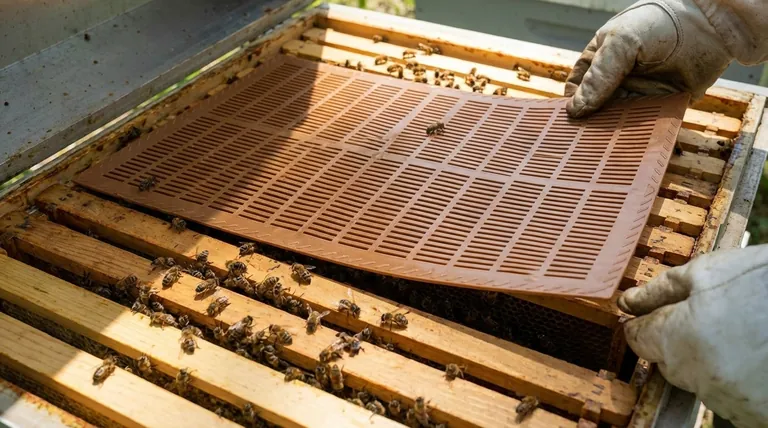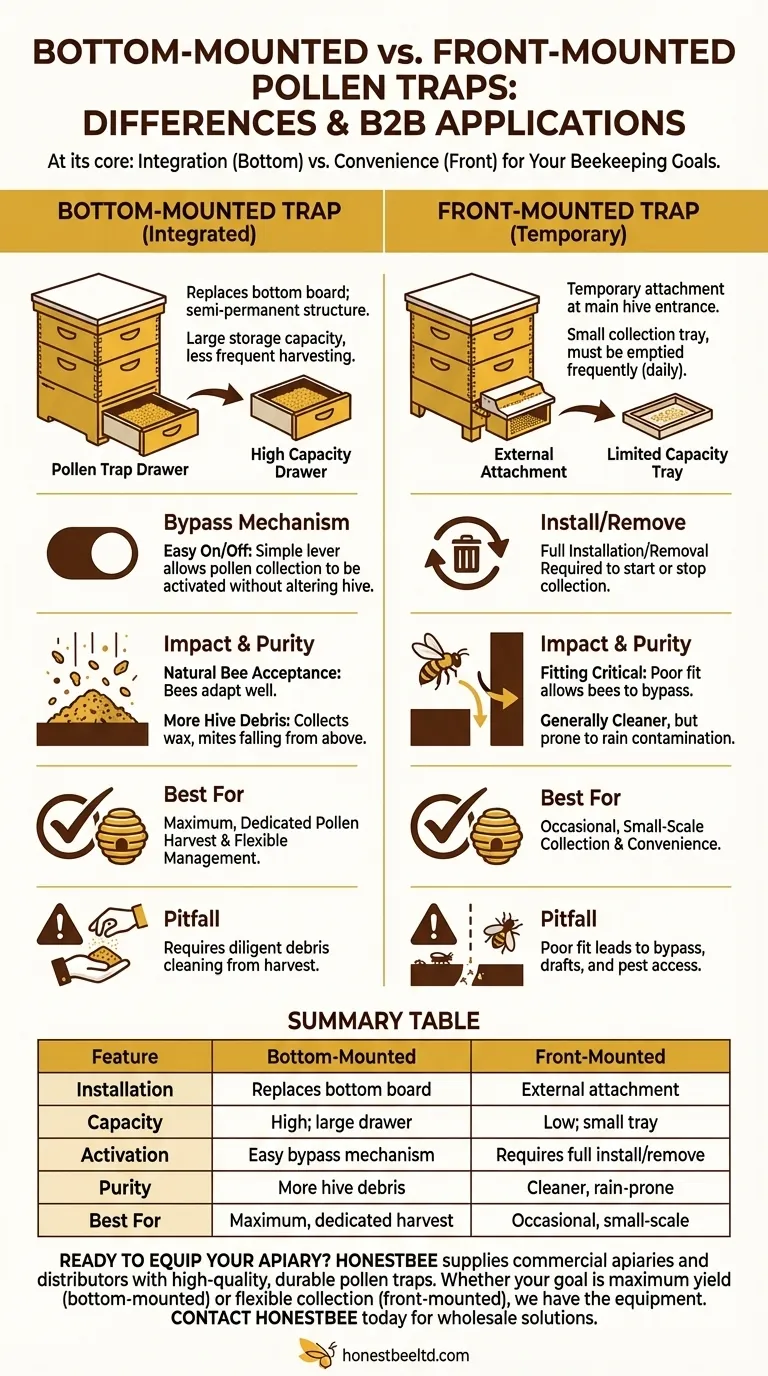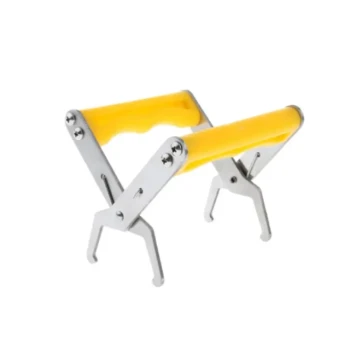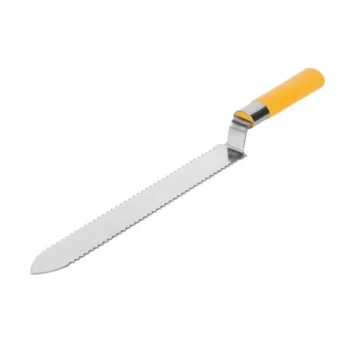At its core, the difference between bottom-mounted and front-mounted pollen traps is a choice between integration and convenience. Front-mounted traps are temporary, external attachments for smaller-scale collection, whereas bottom-mounted traps are integrated, higher-capacity systems designed for more dedicated harvesting.
Your decision is not about which trap is universally "better," but which tool is right for your specific beekeeping goals. The choice balances pollen yield, ease of use, and the potential impact on your colony's daily routine.

Core Design and Functionality
The physical placement of the trap dictates its primary characteristics, from how much pollen it can hold to how the bees interact with it.
Installation and Permanence
A front-mounted trap, often called a "front porch" trap, is an external device you attach to the main hive entrance. It is designed for temporary use and can be installed or removed in minutes.
A bottom-mounted trap replaces the hive's standard bottom board, becoming a semi-permanent, integrated part of the hive structure. It sits underneath the lowest brood chamber.
Pollen Collection Capacity
Due to its small, external design, a front-mounted trap has a very limited collection tray. It must be emptied frequently, often daily, to prevent overflow and spoilage.
Bottom-mounted traps feature a much larger collection drawer. This gives them a significantly greater storage capacity, allowing for less frequent harvesting.
Activating and Deactivating the Trap
To collect pollen with a front-mounted trap, you must have it fully installed. To stop collecting, you must remove the entire device from the entrance.
Bottom-mounted traps are far easier to toggle. They typically feature a bypass mechanism that can be opened or closed, allowing you to turn pollen collection "on" or "off" without altering the hive structure.
Understanding the Impact on the Hive
Any pollen trap alters how bees enter their home. Understanding these impacts is critical for maintaining a healthy and productive colony.
Bee Acceptance and Entrance Behavior
The fit of a front-mounted trap is critical. If it is not perfectly flush with the hive body, bees may discover and begin using the gaps as a new entrance, bypassing the trap entirely and rendering it useless.
Because a bottom-mounted trap is the entrance, bees adapt to it more naturally. The risk of bees creating alternative entrances is much lower.
Pollen Purity and Debris
Bottom-mounted traps are positioned directly below the entire colony. As a result, they tend to collect more hive debris (wax fragments, mites, etc.) that falls from the frames above, mixing with the clean pollen.
Front-mounted traps are external and are generally less prone to collecting internal hive debris, but their small size makes them more susceptible to contamination from rain if not properly sheltered.
Common Pitfalls to Avoid
While effective, both trap designs come with trade-offs that every beekeeper must consider.
The Front Trap Fitting Problem
The single biggest failure point for front-mounted traps is a poor fit. This not only allows bees to bypass the trap but can also create drafts or allow pests like wax moths or small hive beetles easier access.
The Bottom Trap Debris Issue
The convenience and capacity of a bottom-mounted trap are offset by the need for more diligent pollen cleaning. You must be prepared to sift debris from your harvest to ensure a high-quality final product.
General Pest Attraction
Be aware that any pollen trap can potentially attract pests. The collection drawer, with its store of protein-rich pollen, can become a target for small hive beetles if not managed and emptied regularly.
Making the Right Choice for Your Goal
Select your equipment based on a clear objective. There is no one-size-fits-all solution.
- If your primary focus is maximum pollen harvest: A bottom-mounted trap is the superior choice due to its large capacity and integration with the hive.
- If your primary focus is occasional or small-scale collection: A front-mounted trap offers unmatched convenience for temporary use without long-term hive modification.
- If your primary focus is flexibility and ease of management: The ability to easily turn a bottom-mounted trap on and off makes it ideal for managing collection periods with minimal disruption.
Ultimately, choosing the right pollen trap is about aligning the tool with your specific beekeeping philosophy and harvesting needs.
Summary Table:
| Feature | Bottom-Mounted Trap | Front-Mounted Trap |
|---|---|---|
| Installation | Replaces bottom board; semi-permanent | External attachment; temporary |
| Capacity | High; large collection drawer | Low; small tray, requires frequent emptying |
| Activation | Easy on/off bypass mechanism | Requires full installation/removal |
| Purity | More hive debris (wax, mites) | Generally cleaner, but prone to rain |
| Best For | Maximum, dedicated harvest | Occasional, small-scale collection |
Ready to equip your apiary with the right pollen trap?
HONESTBEE supplies commercial apiaries and beekeeping equipment distributors with high-quality, durable pollen traps and other essential beekeeping supplies through our wholesale-focused operations. Whether your goal is maximum yield with a bottom-mounted system or flexible collection with a front-mounted model, we have the equipment to support your success.
Contact HONESTBEE today to discuss your specific needs and discover how our wholesale solutions can enhance your operation's efficiency and profitability.
Visual Guide

Related Products
- 8 Frame and 10 Frame Propolis Trap Collector Screen for Propolis Collection
- Reusable Clear Small Hive Beetle Traps for Beehives Beetle Trapping Tools
- Black Plastic Beetle Barn Hive Beetle Trap for Beehives
- Professional Galvanized Hive Strap with Secure Locking Buckle for Beekeeping
- Ergonomic High Visibility Plastic Frame Grip Handles
People Also Ask
- What method is used to collect venom from honey bees? A Guide to Modern, Non-Lethal Extraction
- How do beekeepers ensure sustainable harvesting of propolis? Prioritize Hive Health for Long-Term Yield
- How should a hive tool be used for hive inspection? Master the Essential Beekeeper's Multi-Tool
- Do beekeepers have to use a propolis trap? A Guide to Harvesting Bee Glue Efficiently
- Can any hive have a propolis trap? Only if your colony is strong enough.



















